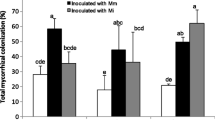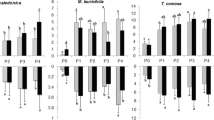Abstract
The resurrection flowering plant Ramonda serbica inhabits the shallow organo-mineral soil that develops in crevices on northern-facing carbonate rocks in the gorges in the Balkan Peninsula. This type of soil represents a complex substrate whose physical and chemical properties were found to be well suited to the most important requirements for the growth and development of R. serbica as well as for the plant’s survival in the state of anhydrobiosis in periods of drought stress. Considerable amount of organic matter (39.4%) in the soil resulted in the high field capacity (134 ml/100 g soil) as well as the slow changes in the amount of its available water. The suitable soil hydric status, based on the organic remains, supports the slow dehydration of this poikilohydric plant, which is extremely important in allowing the activation of the plant’s protective mechanisms. The pH of the soil solution was slighty alkaline (7.7) mostly due to carbonates in its crystallographic structure. The large amount of incompletely decomposed organic debris resulted in a marked difference between total and available nutrient concentration in the soil. Still, the adequate content of nutrients in the leaves points to efficient mineral consumption by the plant roots. The sufficient bioavailability of nutrients and water was also improved by vesicular–arbuscular mycorrhiza detected in R. serbica roots.


Similar content being viewed by others
References
Allen RJL (1940) The estimation of phosphorus. Biochem J 34:858–865
Alpert P (2006) Constraints of tolerance: why are desiccation-tolerant organsisms so small or rare? J Exp Biol 209:1575–1584. doi:10.1242/jeb.02179
Augusti A, Scartazza A, Navari-Izzo F, Sgherri CLM, Stevanović B, Brugnoli E (2001) Photosystem II photochemical efficiency, zeaxanthin and antioxidant contents in the poikilohydric Ramonda serbica during dehydration and rehydration. Photosynth Res 67:79–88. doi:10.1023/A:1010692632408
Barr HD, Weatherley PE (1962) A re-examination of the relative turgidity technique for estimating water deficit in leaves. Aust J Biol Sci 15:413–428
Bewley JD, Krochko JE (1982) Desiccation-tolerance. In: Lange OL, Nobel PS, Osmond CB, Ziegler H (eds) Physiological plant ecology II. Water relations and carbon assimilation. Springer-Verlag, Berlin, pp 325–379
Black M, Pritchard HW (eds) (2002) Dessication and survival in plants: drying without dying. CABI Publishing, Wallingford, UK
Bornyasz MA, Graham RC, Allen MF (2005) Ectomycorrhizae in a soil-weathered granitic bedrock regolith: Linking matrix resources to plants. Geoderma 126:141–160. doi:10.1016/j.geoderma.2004.11.023
Bremner JM, Keeney DR (1965) Steam distillation methods for determination of ammonium, nitrate and nitrite. Anal Chim Acta 32:485–495. doi:10.1016/S0003-2670(00)88973-4
Bremner JM, Mulvaney CS (1982) Nitrogen-total. In: Page AL (ed) Methods of soil analysis. Agronomy monograph 9, vol 2, 2nd edn. American Society of Agronomy, Madison, WI, pp 595–624
Cecconi S, Polesello A (1956) Annali sperimentazione agraria X:127
Dražić G, Mihailović N, Stevanović B (1999) Chlorophyll metabolism in leaves of higher poikilohydric plants Ramonda serbica Panč. and Ramonda nathaliae Panč. et Petrov. during dehydration and rehydration. J Plant Physiol 154:379–384
Farrant JM (2000) A comparison of mechanisms of desiccation tolerance among three angiosperm resurrection plant species. Plant Ecol 151(1):29–39. doi:10.1023/A:1026534305831
Fitter AH, Hay RKM (2002) Environmental physilogy of plants, 3rd edn. Academic Press, London
Gensel PG, Edwars D (2001) Plants invade the land. Columbia University Press, New York
Goldberg LF, Ardmino E (1985) Metodi normalizzati di analisi del suolo–Societa’ Italiana della scienza del suolo. Edagricole, Bologna
Jackson ML (1958) Soil chemical analysis. Prentice Hall Inc., Englewood, pp 214–221
Koerselman W, Meuleman AFM (1996) The vegetation N:P ratio: a new tool to detect the nature of nutrient limitation. J Appl Ecol 33:1441–1450. doi:10.2307/2404783
Kunze GW (1965) Pretreatment for mineralogical analysis. In Black CA (ed) Methods of soil analysis. Part 1. Agronomy monograph 9. Madison, pp 568–577
Marschner H (1995) Mineral nutrition of higher plants. Academic Press, London
Markovska Y, Tsonev T, Kimenov G (1996) Regulation of CAM and respiratory recycling by water supply in higher poikilohydrous plants–Haberlea rhodopensis Friv. and Ramonda serbica Panc. at transition from biosis to anabiosis and vice versa. Bot Acta 110:18–24
MiRAAF (Ministero delle Risorse Agricole Alimentari e Forestali) (1992) Metodi ufficiali di analisi chimica del suolo. Roma, 205 pp
Navari-Izzo F, Rascio N (1999) Plant responses to water–deficit conditions. In: Pessarakli M (ed) Handbook of plant and crop stress. Marcel Dekker, Inc., New York, pp 231–270
Navari-Izzo F, Pinzino C, Quartacci MF, Sgherri CLM, Izzo R (1994) Intracellular membranes: kinetics of superoxide production and changes in thylacoids of resurrection plants upon dehydration and rehydration. In: Proceedings of royal society of Edinburgh 102 B, Edinburgh (Scotland), pp 187–191
Navari-Izzo F, Ricci C, Vazzana C, Quartacci MF (1995) Unusual composition of thylacoid membranes of the resurrection plant Boea hygroscopica: changes in lipids upon dehydration and rehydration. Physiol Plant 94:135–142. doi:10.1111/j.1399-3054.1995.tb00794.x
Oliver MJ, Bewley JD (1997) Desiccation-tolerance in plant tissues. A mechanistic overview. Hortic Rev (Am Soc Hortic Sci) 18:171–214
Oliver MJ, Tuba Z, Mishler BD (2000) The evolution of vegetative desiccation tolerance in land plants. Plant Ecol 151:85–100. doi:10.1023/A:1026550808557
Olsen SR, Cole CV, Watanabe FS, Dean LA (1954) Estimation of available phosphorus in soils by extraction with sodium bicarbonate. US Department of Agriculture, Circular No. 939, Washington
Phillips JM, Hayman DS (1970) Improved procedures for clearing roots and staining parasitic and vesicular-arbuscular mycorrhizal fungi for rapid assessment of infection. Br Mycol Soc Trans Camb 55:158–161
Pico FW, Riba M (2002) Regional-scale of Ramonda myconi: Remnant population dynamic in a preglacial relict species. Plant Ecol 161:1–13. doi:10.1023/A:1020310609348
Porembski S, Barthlott W (2000) Granitic and gneissic outcrops (inselbergs) as centers of biodiversity for desiccation-tolerant vascular plants. Plant Ecol 151:19–28. doi:10.1023/A:1026565817218
Quartacci MF, Glišić O, Stevanović B, Navari-Izzo F (2002) Plasma membrane lipids in the resurrection plant Ramonda serbica following dehydration and rehydration. J Exp Bot 53(378):2159–2166. doi:10.1093/jxb/erf076
Rascio N, La Rocca N (2005) Resurrection plants: the puzzle of surviving extreme vegetative desiccation. Crit Rev Plant Sci 24:209–225. doi:10.1080/07352680591008583
Sgherri C, Stevanović B, Navari-Izzo F (2004) Role of phenolics in the antioxidative status of the resurrection plant Ramonda serbica during dehydration and rehydration. Physiol Plant 122:478–485. doi:10.1111/j.1399-3054.2004.00428.x
Stevanović B, Glišić O (1997) Eco-anatomical differences between Balkan endemo-relict species of Gesneriaceae. Bocconea 5(2):661–666
Stevanović V, Niketić M, Stevanović B (1987) Fitocenološke karakteristike simpatričkih staništa endemo-reliktnih vrsta Ramonda serbica Panč. i R. nathaliae Panč. et Petrov. Glasnik Instituta za botaniku i Botaničke bašte Univerziteta u Beogradu XXI:17–26, Beograd (in serbian with english abstract)
Stevanovic B, Thu PTA, de Paula FM, da Silva JV (1992) Effects of dehydration and rehydration on the polar lipid and fatty acid composition of Ramonda species. Can J Bot 70:107–113. doi:10.1139/b92-015
Taiz L, Zeiger E (1998) Plant physiology, 2nd edn. Sinauer Associates, Inc. Publishers, Sunderland
Živković T, Quartacci MF, Stevanović B, Marinone F, Navari-Izzo F (2005) Low molecular weight substances in the poikilohydric plant Ramonda serbica during dehydration and rehydration. Plant Sci 168:105–111. doi:10.1016/j.plantsci.2004.07.018
Acknowledgments
This work was supported by Interuniversity project between the Faculty of Biology, University of Belgrade, Serbia (promotor Prof. Dr. Branka Stevanović) and the Faculty of Agriculture, University of Pisa, Italy (promotor Prof. Dr. Flavia Navari-Izzo) and by the Ministry of Science of Serbia, Grant No. 143015. We are grateful to anonymous reviewers for very valuable comments on this manuscript.
Author information
Authors and Affiliations
Corresponding author
Rights and permissions
About this article
Cite this article
Rakić, T., Quartacci, M.F., Cardelli, R. et al. Soil properties and their effect on water and mineral status of resurrection Ramonda serbica . Plant Ecol 203, 13–21 (2009). https://doi.org/10.1007/s11258-008-9498-7
Received:
Accepted:
Published:
Issue Date:
DOI: https://doi.org/10.1007/s11258-008-9498-7




